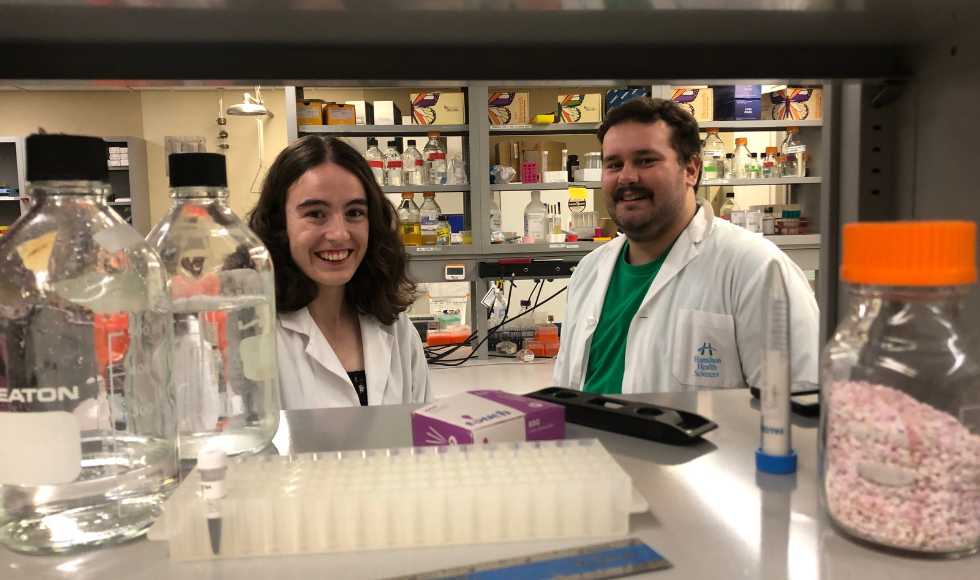Health Sciences lab opens its doors to biology undergrad on a mission

Undergraduate Science student Sierra Vaillancourt spent two weeks getting a crash course in phages research from Health Sciences graduate student Felix Croteau. Sierra took what she learned back to supervisor Rebecca Batstone’s lab to expand its research capabilities. “Science is at its best when it’s collaborative,” says Felix.
BY Jay Robb, Faculty of Science
November 9, 2023
Rebecca Batstone had a problem. Sierra Vaillancourt came up with the solution. And Alexander Hynes, from a different faculty, helped make it happen.
Batstone, an assistant professor in the Faculty of Science’s department of biology, wanted to start working with bacteriophages — viruses that selectively hunt and kill bacteria.
“If we had phages, we could start running experiments that explore fundamental questions in evolutionary biology,” Batstone told her team.
But phages aren’t easy to work with and handling them requires special skills — skills no one in her lab had at the time.
So Vaillancourt, a fourth-year science student working in Batstone’s lab, took up the challenge, making it her mission to stock the lab with phages.
Batstone recommended Vaillancourt read up on phages research by Alexander Hynes, an associate professor in the Faculty of Health Sciences and a member of the Farncombe Family Digestive Health Research Institute.
They’d first met at Memorial University when Batstone was starting her master’s and Hynes was finishing his PhD.
After reading Hynes’ research, Vaillancourt emailed him. Hynes, who runs a phages bootcamp for students in his lab, invited Vaillancourt to enroll — the first undergraduate student from outside his lab to participate in it.
He also tapped graduate student Felix Croteau to be Vaillancourt’s guide into the world of phages research.
Over the course of nearly two weeks, she learned how to amplify phages and conduct both plaque and adsorption assays.
“The work I’m doing in Dr. Batstone’s lab wouldn’t have been possible without the bootcamp and Felix’s help,” says Vaillancourt.
Vaillancourt returned to Batstone’s lab, familiar with protocols on everything from growth curves and phage titrations to phage DNA extraction procedures.
“Because of Felix, I started working on a research project in Dr. Batstone’s lab that I’m passionate about,” she says.
“Everyone in Dr. Hynes’ lab was incredibly welcoming, I can’t say enough about how grateful I am for all their help.”
Croteau says he was happy to lend a hand. “Supervising Sierra was a great experience. Science is at its best when it’s collaborative across departments and disciplines,” he says.
“I think phages are some of the coolest things in the microbial world and I’m always happy to see other scientists develop an interest.”
Along with sharing her newfound knowledge in Batstone’s lab, Vaillancourt connected with a PhD student at the University of Toronto who is researching the same bacterial species, to offer up advice, protocols and phage stock.
“I got to pay it forward,” says Vaillancourt.
Batstone’s lab is now stocked with phages, underscoring the drive and curiosity of undergraduate students and the spirit of collaboration at McMaster, Batstone says.
“Sierra took the initiative. Dr. Hynes welcomed Sierra into her lab. And Felix did an outstanding job of showing her the ropes. Because of Sierra, Alex and Felix, our lab’s ready to begin working with phages.”
I’m quite excited. I study the evolution of cooperation, so it’s fitting that scientific progress in my lab relies on cooperation with other labs and researchers. It’s great that Mac fosters these types of interactions.”


